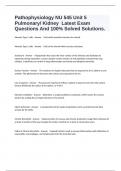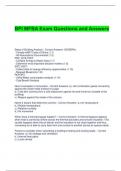Pathophysiology NU 545 Unit 5
Pulmonary/ Kidney Latest Exam
Questions And 100% Solved Solutions.
Alveolar Type 1 cells - Answer Cells which provides structure for alveoli.
Alveolar Type 2 cells - Answer Cells of the alveoli which secrete surfactant.
Surfactant - Answer A lipoprotein that coats the inner surface of the alveolus and facilitates its
expansion during inspiration. Lowers alveolar surface tension at end expiration and prevents lung
collapse. Contributes to control of lung inflammation and innate and adaptive immunity.
Surface Tension - Answer The tendency for liquid molecules that are exposed to air to adhere to one
another. This phenomenon decreases the surface area exposed to the air.
Law of Laplace - Answer The pressure required to inflate a sphere is equal to two times the surface
tension divided by the radius of the sphere, or P=2T/r.
Alveolar ventilation - Answer Distention, is made possible by surfactant, which lowers the surface
tension by coating the air-liquid interface in the alveoli.
Infant Surfactant - Answer Is produced by 20-24 weeks of gestation and is secreted into the fetal
airways by 30 weeks.
Chronic Bronchitis - Answer Hypersecretion of mucous and chronic productive cough that continues for
at least 3 months of the year (usually the winter months) for at least 2 consecutive years.
Patho of Chronic Bronchitis - Answer Inspired irritants result in airway inflammation with infiltration of
neutrophils, macrophages, and lymphocytes into the bronchial wall.
,Manifestations of Chronic Bronchitis - Answer Decreased exercise intolerance, wheezing, and SOB,
productive cough, evidence of airway obstruction (decrease in FEV1) on spirometry, copious amounts of
sputum, frequent pulmonary infections, FVC and FEV1 values are markedly reduced,FRC and Residual
volume (RV) measurements are increased, decreased alveolar ventilation, increased
PaCO2,polycythemia, cyanosis, pulmonary HTN, cor pulmonale which can lead to severe disability or
death.
Ventilation - Answer The mechanical movement of gas or air into and out the lungs.
Respiration - Answer The exchange of O2 and CO2 during cellular metabolism.
PAO2 - Answer The amount of oxygen in the alveoli.
Gas Transport - Answer The delivery of oxygen to the cells of the body and the removal of CO2.
Pors of Kohn - Answer Tiny pores which permit some air to pass through the septa from alveolus to
alveolus, promoting collateral ventilation and even distribution of air among the alveoli.
Asthma - Answer A chronic inflammatory disorder of the bronchial mucosa that causes bronchial
hyperresponsiveness, constriction of the airways, and variable airflow obstruction that is reversible.
Acinus - Answer Consists of respiratory bronchioles, alveolar ducts, and alveoli.
Early Asthmatic Response - Answer Antigen exposure to bronchial mucosa activates dendritic cells to
present the antigen to CD4+ Tcells, which differentiate into Th2 cells. These cells release numerous
cytokines IL-4, IL-5, IL-8 & IL-13.
IL-4 - Answer In Asthmatic response it stimulates B-cell activation, proliferation, and production of
antigen-specific IgE.
IgE - Answer In asthmatic response it causes mast cell degranulation with the release of a large number
of inflammatory mediators (histamine, prostaglandins, and leukotrienes)
, IL-5 - Answer In asthmatic response it stimulates the activation, migration, and proliferation of
eosinophils, which cause direct tissue injury and release toxic neuropeptides that contribute to increased
bronchial hyperresponsiveness, fibroblast proliferation, and airway scarring.
IL-8 - Answer In asthmatic response it activates polymorphonucleocytes that contribute to a more
exaggerated inflammatory response.
IL-13 - Answer In asthmatic response it impairs mucociliary clearance, enhances fibroblast secretion,
and contributes to bronchoconstriction.
TNF, IL-1 - Answer In asthmatic response it alters muscarinic receptor function, leading to increased
levels of acetylcholine, which causes bronchial smooth muscle contraction and mucus secretion
-These changes, combined with epithelial cell damage (caused by eosinophil infiltration) produce acute
airway hyperresponsiveness and obstruction.
Late Asthmtic Response - Answer Begins 4-6 hrs after the early response. Chemotactic recruitment of
lymphocytes, eosinophils, and neutrophils during the acute response causes a latent release of
inflammatory mediator's again inciting bronchospasm, edema, and mucus secretion with obstructive
airflow.
Airway Remodeling - Answer Untreated inflammation which can lead to long-term airway damage that
is irreversible.
Oxygen - Answer Is transported in the blood in two forms.
1. a small amount dissolves in plasma
2. the remainder binds to hemoglobin molecules
Carbon Dioxide - Answer Is carried in the blood in three ways:
1. Dissolved in plasma
2. As bicarbonate
3. As carbamino compound





